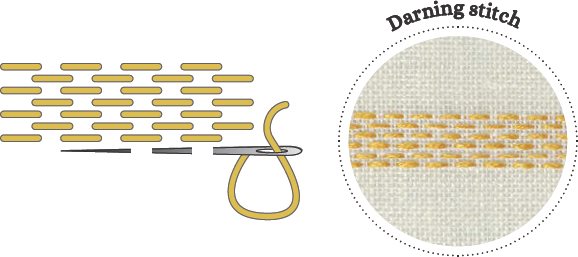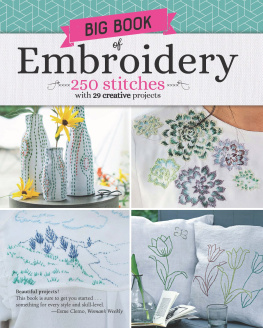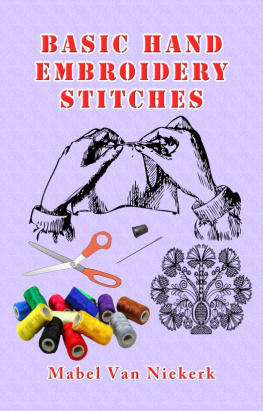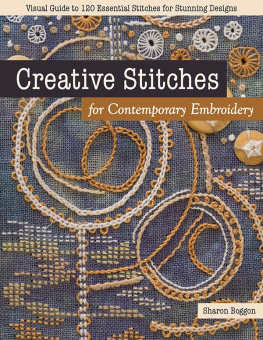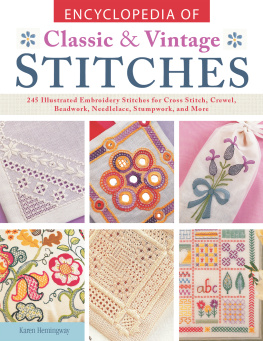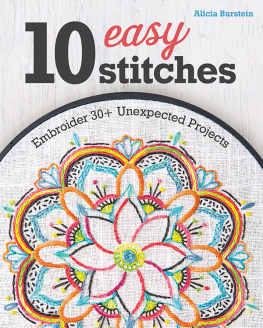Although the success of an embroidery project depends mostly on the quality of the material and the thread used, it also depends on the harmony between the two.

MATERIALS
MOST FABRICS CAN BE EMBROIDERED IF THEY ARE OF GOOD QUALITY.
Cotton, yarn, blended fabrics, linen, and anything in canvas, are the more durable types. They can be washed and are suitable for all types of embroidery. They are available commercially and vary in thickness. Since they are tightly woven, it is easy to reproduce the design patterns in order to complete works that require great precision such as hemstitches, white stitches, and pulled-thread embroidery.
Cheesecloths are suitable for any type of counted-stitch embroidery. Because their weaving is simple and somewhat tight, you can count the floss, above which the stitches are embroidered as they follow the pattern of the diagram.
FLOSS
DMC MILLED COTTON EMBROIDERY FLOSS
It is 100% cotton, and comprises 6 separable strands. As such, it can be used on almost any type of material. It is available in 8.7 yard (8m) skeins that are either plain or have multiple colors and can be used for both traditional and counted cross-stitch embroidering.
Aida cloth is the easiest to use; its double weaving effortlessly holds regular stitches.
Wool and silk can also be used but often require dry cleaning.
A preferred material for tapestry, canvas is available in cotton, hemp, and linen, as well as single-thread canvas and double-thread canvas, known as Penelope.
Single-thread canvas is reserved for horizontal and vertical stitches, whereas Penelope canvas can be used for all other types and can even be undoubled by stitching into all the holes. They are commercially available in varying thickness and widths, sold by the foot (meter).
DMC METALLIC EMBROIDERY FLOSS
Its appearance is similar to that of milled cotton floss. It is synthetic and can only be washed at 104F (40C) and therefore cannot be used on all types of material. It is delicate and difficult to work with.
DMC PEARL COTTON
It is 100% cotton, very twisted, and is available in sizes. It is available in skeins, bobbins, or balls for the thinner floss.
DMC COLBERT TAPESTRY WOOL
It is a twisted, mothproof floss with solid colors and is 100% virgin wool. It is mainly used to embroider on canvas.
DMC MATTE TWISTED COTTON
This is a matte floss that is also 100% cotton.
EQUIPMENT
NEEDLES
Embroidery needles are short, with a long, wide eye that allows you to thread relatively thick strands and to pass through the fabric by spreading its thread to allow the embroidery thread to follow with the least possible wear.
Needles have round tips for working on cheesecloths and pointed tips for working on canvas. They are available in different sizes and lengths to correspond with the material and floss.
Beading needles are very long and thin so that you can thread several beads at once.
Wool needles have a very long, wide eye to allow you to thread thick strands of wool or cotton.
SCISSORS
Two pairs of scissors are required. Dressmakers scissors are used to cut the cloth and a small, sharp pair of embroidery scissors is used to cut the embroidery floss, the fabric in the hemstitch, or the fabric threads in pulled-thread embroidery.
EMBROIDERY HOOPS
They consist of two wooden circles. The outer circle has a screw so that you can enlarge it to fit on the slim lining of the fabric to be embroidered. There are several sizes. For very big embroidery projects or tapestry, use a slatted loom, with or without a foot.
THIMBLES
They protect the middle finger of the hand used to embroider and allow you to push the needle without the risk of injury. They are available in metal and porcelain and come in different sizes.
MAINTAINING EMBROIDERED WORKS
Embroidered works must be washed with greater care than regular hand- or machine-washed fabrics. They should be encased in a buttoned pillowcase and washed on a delicate cycle.
The spin cycle should be as gentle as possible. After drying, cotton embroideries are steam ironed on the reverse side, while resting against a thick fleece and placing a clean, white cloth between the iron and the embroidered work.
Wool embroideries are also ironed on the reverse side, but with a dry iron, always taking care to place a clean, white cloth between the iron and the embroidered work.
MEASUREMENTS
Throughout this book, both US and metric measurements are given. When making your projects, do not mix the two. Use either all US or all metric measurements.

STRAIGHT STITCH VARIATIONS

THESE ARE THE EASIEST STITCHES, PERFECT FOR NOVICE EMBROIDERERS. THEY ONLY REQUIRE A LITTLE PRACTICE TO GET A CONSISTENT STITCH.
For a printable PDF of the patterns used in this book, please contact Fox Chapel Publishing at , quoting the ISBN and title of this book, as well as the pattern or patterns required.

This stitch is embroidered in a line, alternatively passing the needle above and below to produce consistent stitches.
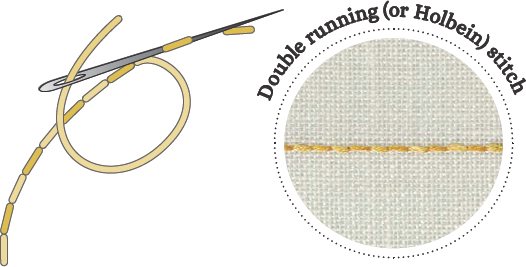
After having completed a line of running stitch, switch to the opposite direction while interleaving stitches.
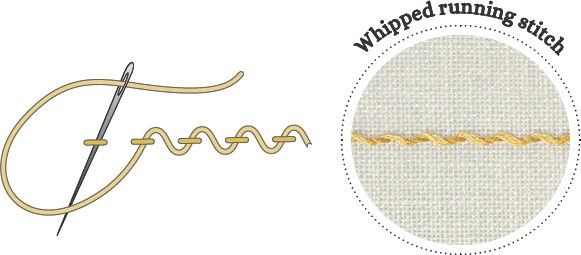
First embroider a line of running stitches. Then, with a different needle and another floss, embroider an overlock stitch passing the needle from right to left and top to bottom under each running stitch.

Embroider a second line of overlock stitches from left to right and top to bottom.
